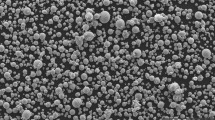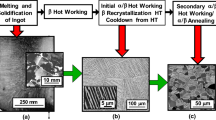Conclusions
-
1.
Tests of quenched Ti−Mo alloys show two valleys in the yield strength curves. One of them is associated with martensitic α″ phase and the other with mechanically unstable β phase. The two valleys are separated by a peak associated with the formation of ω phase in β phase of the critical composition during quenching.
-
2.
No ω phase is formed in quenched alloys VT6 and VT16. The valley of the yield strength associated with the α″ phase runs together with the valley associated with unstable β phase.
-
3.
The low yield strength of quenched alloys consisting of α″ phase is due to a low shear modulus, while in alloys with mechanically unstable β phase it is due to the macroscopically oriented transformation of β phase to martensite under the influence of applied stress.
-
4.
The valley in the yield strength of quenched alloy VT16 does not lead to any improvement in workability in upsetting of cylindrical samples or coldheading of bolts.
Similar content being viewed by others
Literature cited
R. I. Jaffee, "Fundamentals of metal science of titanium alloys," Uspekhi Fiziki Metallov, 4, 77–191 (1961).
V. N. Moiseev and L. V. Geras'kova, "Change in structure and properties of titanium alloys with heat treatment," Metal. i Term. Obrabotka Metal., 5, 3–9 (1965).
A. D. Lyuchkov et al., "Deformability of some α+β and β titanium alloys in cold condition," in: Titanium Alloys for New Technology [in Russian] (1968), pp. 257–261.
M. I. Ermolova et al., "Phase and structural transformations in biphase commercial titanium alloys," in: Titanium Alloys for New Technology [in Russian] (1968), pp. 145–153.
V. N. Moiseev, "Martensitic transformation during deformation of titanium alloys with metastable β phase," Metal. i Term. Obrabotka Metal., 5, 18–23 (1972).
V. A. Smal'shchenko, "Effect of heat treatment on deformability of titanium alloy VT16 during cold rolling," Tekhnologiya Legkikh Splavov, 1, 65 (1973).
Additional information
Moscow Aviation Technology Institute. Translated from Metallovedenie i Termicheskaya Obrabotka Metallov, No. 8, pp. 52–56, August, 1975.
Rights and permissions
About this article
Cite this article
Kolachev, B.A., Mamonova, F.S. & Lyasotskaya, V.S. Characteristics of the structure and properties of quenched titanium alloys. Met Sci Heat Treat 17, 695–697 (1975). https://doi.org/10.1007/BF00664320
Issue Date:
DOI: https://doi.org/10.1007/BF00664320




